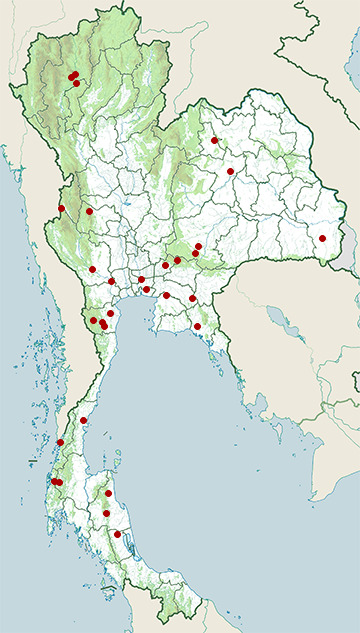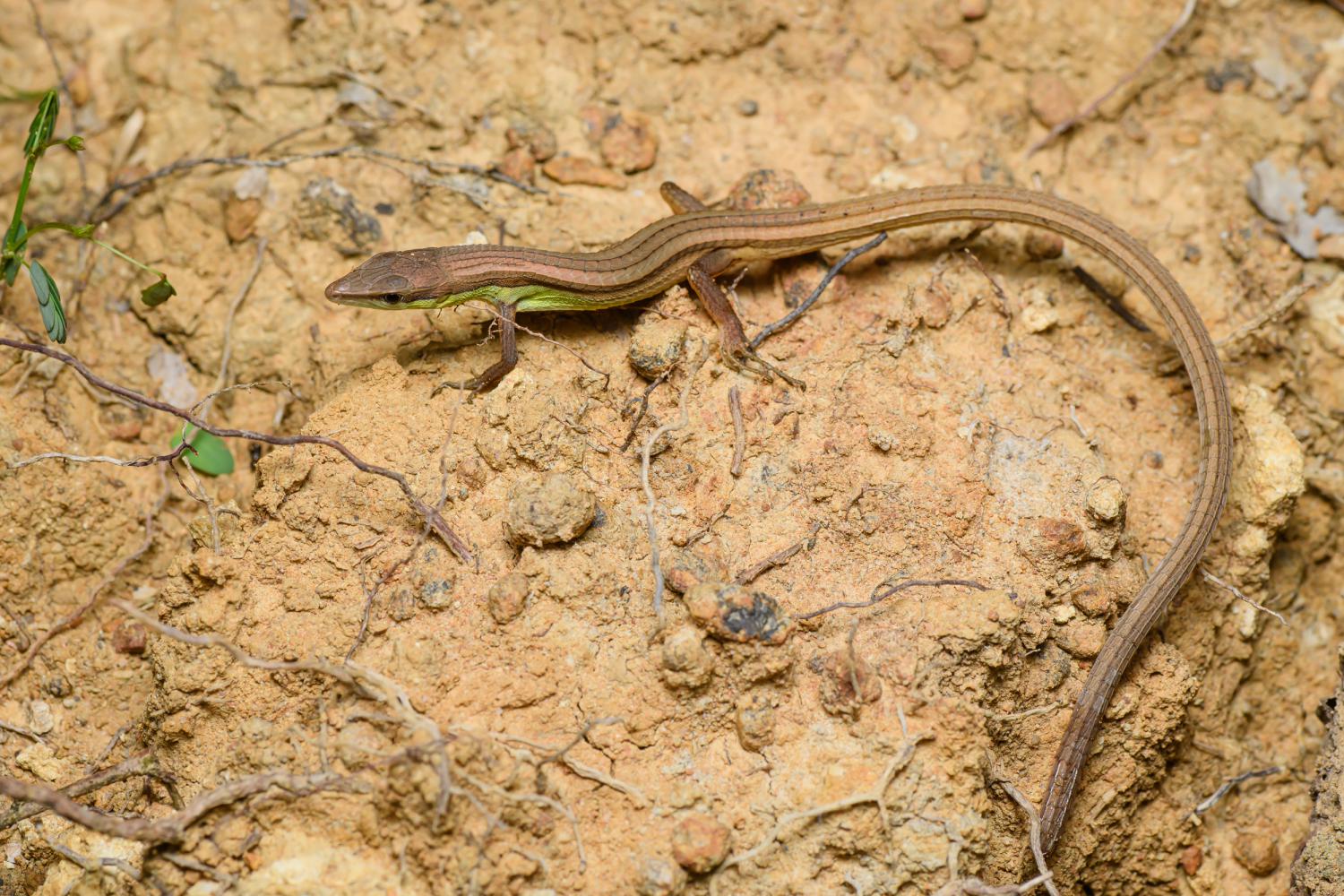Species of Thailand
Six-striped grass lizard
Takydromus sexlineatus
François Marie Daudin, 1802
In Thai: กิ้งก่าน้อยหางยาว
The Asian grass lizard, six-striped long-tailed lizard, or long-tailed grass lizard (Takydromus sexlineatus) is an arboreal, diurnal species of lizard. The tail length is usually over three times the body (snout to vent) length in this species.
Males and females are similar, males being distinguishable by the presence of pre-anal pores. On average they grow to around 12 cm abbrv=on
snout-to-vent length, with the addition of a distinctive, prehensile long tail. Some individuals may have small circular spots on the sides of the bodies. This species of lizard is kept as a pet.
Like geckos they can drop their tail and grow a new one when attacked.
Appearance
The Long Tailed grass lizard is easily identifiable by a long tail, and has a white to cream coloured underbelly with a brown, green or beige back, often adorned with brown stripes of different shades. It typically has a small head with a sharply pointed snout and black or pink tongue. Its body is slightly elongated and thin with small pointy scales beneath the chin resembling a beard. Males have white spots on their sides, while females do not. Males have tails that thicken past the vent and are generally thicker than the female's down the entire length of the tail. The light stripes on the length of the body are yellower than the female's, which are more cream colored. They grow up to 12 inches (30 cm.) long, with the tail usually being three times their body length.
Distribution
The Takydromus sexlineatus is found throughout South East Asia, and is native to a number of countries including India, China, Thailand, and Indonesia. The subspecies ocellatus is found in areas such as southern China, north Burma and north Malaysia.
Behavior
These are entirely diurnal lizards that emerge in the early morning to bask in the sun. If a potential predator approaches they will first remain completely still, and then if the danger persists, they will flee to the safety of foliage. Both sexes use arm-waving gestures (similar to a front crawl swimming action), apparently to communicate with each other. They are very agile and fast.
Diet
Takydromus sexlineatus feeds on small insects such as flies, In captivity they can be reared on Crickets and like other small lizards may require a calcium substitute. It is advisable in captivity to vary food including mealworms, sterile maggots or waxworms in addition to crickets although it is possible to feed them garden caught insects. Unlike some larger reptiles, these lizards have extremely fast reactions and have been observed jumping into the air to catch flying prey such as flies.
Thai folklore
In Thailand Takydromus sexlineatus was called S̄āngh̄̀ā () or Ngūkhā (งูคา) a mysterious creature that no one knows what the reality is. It is believed that it was a snake with legs. And a venomous animal bites to be death.
This article uses material from Wikipedia released under the Creative Commons Attribution-Share-Alike Licence 3.0. Eventual photos shown in this page may or may not be from Wikipedia, please see the license details for photos in photo by-lines.
Scientific classification
- Kingdom
- Animalia
- Phylum
- Chordata
- Class
- Reptilia
- Order
- Squamata
- Suborder
- Lacertilia
- Family
- Lacertidae
- Genus
- Takydromus
- Species
- Takydromus sexlineatus
Common names
- German: Sechsstreifen-Langschwanzeidechse
- English:
- Asian grass lizard
- Six-striped long-tailed grass lizard
- Long-tailed lizard
- Thai:
- กิ้งก่าน้อยหางยาว
- จิ้งเหลนน้อยหางยาว
- สางห่า
Subspecies
Takydromus sexlineatus ocellatus, Georges-Frédéric Cuvier, 1829
Range: S China, Hainan, Thailand, Laos, Cambodia, Vietnam, N Burma, N Malaysia.
Takydromus sexlineatus sexlineatus, François Marie Daudin, 1802
Range: India, China, Thailand, Laos, Cambodia, Vietnam, Malaysian Peninsula, Indonesia (Sumatra, Java, Borneo)
Photos
Please help us review our species pages if wrong photos are used or any other details in the page is wrong. We can be reached via our contact us page.
Range Map

- Ban Lat District, Phetchaburi
- Ban Pong District, Ratchaburi
- Bang Khen District, Bangkok
- Bang Phli District, Samut Prakan
- Det Udom District, Ubon Ratchathani
- Hang Dong District, Chiang Mai
- Huai Kha Khaeng Wildlife Sanctuary
- Kaeng Krachan District, Phetchaburi
- Kaeng Krachan National Park
- Khao Ang Rue Nai Wildlife Sanctuary
- Khao Nan National Park
- Khao Sok National Park
- Khao Yai National Park
- Khuan Khanun District, Phatthalung
- Mueang Chiang Mai District, Chiang Mai
- Mueang Chumphon District, Chumphon
- Mueang Kanchanaburi District, Kanchanaburi
- Mueang Khon Kaen District, Khon Kaen
- Mueang Lamphun District, Lamphun
- Mueang Nakhon Nayok District, Nakhon Nayok
- Mueang Nongbua Lamphu District, Nong Bua Lamphu
- Mueang Ranong District, Ranong
- Pak Thong Chai District, Nakhon Ratchasima
- Phanat Nikhom District, Chonburi
- Sakaerat Environmental Research Station
- Sri Phang Nga National Park
- Sukhirin District, Narathiwat
- Tha Mai District, Chanthaburi
- Tha Yang District, Phetchaburi
- Thung Yai Naresuan Wildlife Sanctuary
- Yong Waterfall National Park
